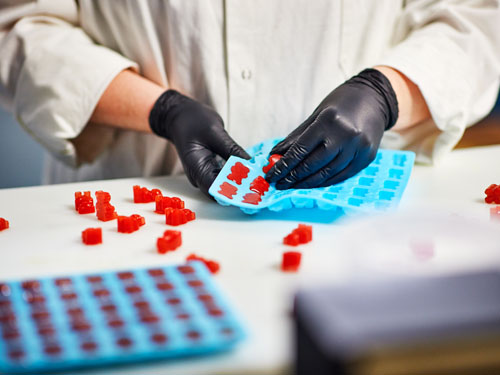Now is the time to lean into a defined strategy to push the boundaries of product development.
A part of that initiative should be leveraging the pipeline of scientific research; a better understanding of this resource can give health and wellness brands a leading edge when developing consumer-preferred products.
Not only can these insights help manufacturers to tap into unmet needs, they can also help you be first to market with a revolutionary new idea.
The power of research
The industry has witnessed an expanding body of research investigating the gut microbiome with a multifold increase in the number of studies relating to this space in just 10 years.
This includes an even greater understanding of how the gut microbiome affects other areas of wellness, including mental, skin and metabolic health.
There is a rising awareness of the benefits that bacteria can have on overall health and this is pushing forward new and exciting clinical trials and science-backed solutions.

Even with the large amount of in vitro and preclinical research completed to date, the number of clinical-stage studies in gut health is more modest … but growing rapidly and looking at physiological systems beyond traditional digestive health.
This includes trials that cover aspects of mental and emotional well-being. Published in 2023, a study conducted by the Institute of Psychiatry, Psychology and Neuroscience (loPPN) at King’s College London examined the consumption of probiotics and found significantly meaningful improvements in mood compared with the placebo group.1
This is just one of many clinical trials demonstrating the ability of probiotics to have an impact on the microbiome and gut-brain axis — and presents innovative possibilities for new product development.
Globally, 81% of dietary supplement users state that clinically proven claims are important to them when purchasing supplements.2 For manufacturers to provide these claims to consumers, trials must first be done using correct scientific protocol.
Ideally, preclinical trials should be conducted in vitro to better understand the attributes, behaviour and mechanisms of the strains, and then in humans to evaluate strain functionality in target populations. These, of course, should be done in accordance with the highest scientific standards.
Identifying these novel strains and proving their efficacy is key to building a portfolio of science-backed solutions. Equally critical is managing the safety of these solutions.
As strains are developed, they must follow the strict guidelines set forth by regulatory organisations such as the European Food Safety Authority (EFSA). In addition, they must be tested to avoid undesired traits, such as mobile genetic elements or deleterious genes.
Tapping into unmet needs
The research that’s happening in the microbiome space is unearthing new opportunities to meet the diverse needs of consumers.
From women’s health to healthy ageing and emotional well-being, new studies that examine how gut health impacts the rest of the body can support product development from concept to commercialisation.
Take the gut-skin axis, for example. The skin contains a microbial system that can be impacted by probiotics. And whether it’s a drive to improve appearance and self-confidence or reducing the signs of ageing, more than two thirds of consumers recognise the link between skin health and overall wellness.3
There is an increasing spotlight on studying biotics that can potentially support aspects of skin health, encouraging solutions beyond topical lotions and serums to capsules and gummies.4,5
Cognitive health is another area of opportunity, with 66% of consumers worldwide stating they’d like to improve their cognitive/mental well-being with supplements.2
This includes solutions that support sleep, stress and overall mental health. Not only are probiotics being studied for their impact on mood, there is growing scientific evidence that botanical extracts can also support cognitive health.

For instance, the University of Canberra in Australia, in collaboration with ADM, is examining the effects of green rooibos tea extract on stress and anxiety.
A connection between gut health and muscle performance and recovery — or the gut-muscle axis — is also beginning to be explored. For instance, a probiotic formulation consisting of three strains has been shown to support biomarkers related to post-exercise oxidative stress.6
There are also studies being done to examine how probiotics can impact athletic support; the use of a spore-forming probiotic strain during offseason training resulted in decreased body fat in female collegiate athletes, for example.7
With global supplement demand for sports nutrition protein and non-protein valued at more than $27 billion in 2023, there is enormous potential in this sector.8
Innovation is essential
While leveraging the research pipeline for scientifically proven solutions that meet current consumer requirements, consideration must also be given to evolving needs and preferences.
This is no longer a one-size-fits-all market, which necessitates innovation in new product development.
Women’s health is a great example. Products marketed “for her” are simply not good enough anymore. Consumers demand more specificity, from functionality to specific life stages.
A consumer survey indicates that more than 70% of women globally are taking a long-term approach to health.9
This should drive innovative solutions that address each stage of life — from adolescence to post-menopause — and all the needs that go with it, including managing premenstrual wellness, pregnancy support, weight management, skin health, addressing hot flushes, cholesterol management and bone health, to name just a few.
Innovation in accessibility is another key area that manufacturers need to address, particularly in functional nutrition, which is an attractive product category for all generations.
Shoppers want options that fit into their existing routines and that are easy to consume.
This is causing a convergence of foods, beverages and supplements with newer formats, such as ready-to-drink functional beverages, fast melts, powder sticks and chewable formats such as gummies, clusters and chocolate squares.
The sensory experiences these formats offer make it more likely for consumers to incorporate ingredients including probiotics into their everyday routines so they see the benefits and become repeat users.
These new formats require a look back at the research pipeline, however, to ensure they’ll perform correctly. Many of them are produced under harsh processing conditions such as high heat or pasteurisation.
This can impact the stability and functional attributes of some probiotic strains. So, they require access to the latest clinical research — such as the work that’s been done with heat-treated postbiotics, which can withstand tough formulation environments — along with technical expertise that can help to overcome some of these manufacturing challenges.
There is no limit
In the coming years, with a growing clinical pipeline generating positive results, there will be a vast range of opportunities to meet the health and wellness needs of consumers.
The functional food market is projected to grow by $285.3 billion by 2030 and, with that type of demand, there will be no shortage of new ingredients.10
Product developers will have to keep their ears to the ground to be up to speed with the latest scientific advancements and connect with the right technical expertise and market knowledge to be on the cutting edge of what’s next.
References
- V. Nikolova, et al., JAMA Psychiatry 80(8), 842–847 (2023).
- https://fmcggurus.com/reports/fmcg-gurus-nutritional-supplements-in-2022-global-report/.
- https://fmcggurus.com/reports/fmcg-gurus-health-wellness-and-the-beauty-within-linking-outer-appearance-with-inner-beauty-global-report-2023/.
- V. Navarro-López, et al., Acta Derm. Venereol. 99, 1078–1084 (2019).
- V. Navarro-López, et al., JAMA Dermatology 154, 37–43 (2018).
- M.S. Macarro, et al., Antioxidants 10(2), 323 (2021).
- J.C. Toohey, et al., J. Strength Cond. Res. 34(11), 3173–3181 (2020).
- Euromonitor Passport Database, Retail Value RSP, USD Million, Fixed 2023 Ex Rates (2023–2028).
- https://fmcggurus.com/reports/fmcg-gurus-healthy-ageing-series-womens-health-global-report-2022/.
- https://www.sphericalinsights.com/reports/functional-food-market.
